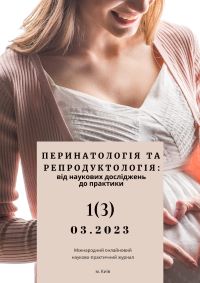Women have unmaturing and perinatal pathology after the unsuccessful attempts of auxiliary genesial technologies
Keywords:
unmaturing, perinatal pathology, auxiliary genesial technologies, prophylaxisAbstract
DOI: 10.52705/2788-6190-2023-01-04
УДК 618.177-089.888.11-089.168:618.3/.7-06:618.39-084
The objective: to study influence of auxiliary genesial technologies on the perinatal results of delivery at a singleton and multifetation.
Materials and methods. All was inspected 100 women, which became pregnant after auxiliary genesial technologies which were up-diffused on the proper groups and sub-groups. 1 a group is 50 women which became pregnant after auxiliary genesial technologies and for them were the used traditional algorithm: a sub-group is 1.1 – 25 women in which were 1-2 unsuccessful attempts of auxiliary genesial technologies and sub-group 1.2 – 25 patients after 3 and anymore unsuccessful attempts of auxiliary genesial technologies. 2 a group is 50 women which became pregnant after auxiliary genesial technologies and conducted after improved by us by the algorithm of prophylaxis of unmaturing: a sub-group is 2.1 – 25 women in which were 1-2 unsuccessful attempts of auxiliary genesial technologies and sub-group 2.2 – 25 patients 3 and more unsuccessful attempts of auxiliary genesial technologies. A control group was made by 25 women which give birth in age from 21 to 30, genesial and somatically healthy.
Research methods: clinical, echographic, cariotocographic, doppler, endocrinology, immunological, microbiological and statistical.
Results. Total frequency of genesial losses for women with the unsuccessful attempts of auxiliary genesial technologies is 31,1% (involuntary breaking in I trimester – 12,0%; miscarriage in a II trimester – 9,1%; premature births in a III trimester – 10,0%). For women from 3 and anymore by unsuccessful attempts level of genesial losses higher on 24,8% (43,5% and 18,7% accordingly).
Perinatal losses make 86,9‰ for women with 1-2 unsuccessful attempts of auxiliary genesial technologies and 95,2‰ – at 3 and anymore. Leading reasons is a respirator distress syndrome on a background intra-amniotic infection and premature removing layer by layer normally located placentas. The leading forms of postnatal morbidity of new-born from women with the unsuccessful attempts of auxiliary genesial technologies is posthypoxic encephalopathy (31,4% - at 3 and more unsuccessful attempts and 28,6% - at 1-2) and realization of the intrauterine infection (18,9% and 14,2% respectively).
Conclusions. It is rotined that the high level of unmaturing of pregnancy, premature births and perinatal pathology for women after the unsuccessful attempts of auxiliary genesial technologies is conditioned by endocrinology, immunological and microbiological changes as a result of massive hormone use at the use of the repeated attempts of auxiliary genesial technologies.
Findings allowed scientifically to ground the necessity of improvement of algorithm of diagnostic and treatment-and-prophylactic measures for women with the unsuccessful attempts of auxiliary genesial technologies in anamnesis with the purpose of decline of frequency of unmaturing of pregnancy and perinatal pathology.


